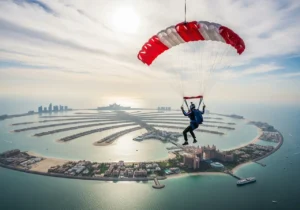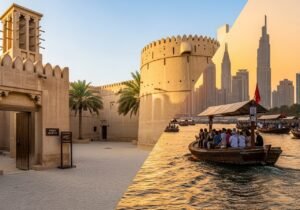Table of Contents
ToggleCapturing the Sands of Time: The Ultimate Guide to Desert Photography Spots
Welcome to a world of profound silence, breathtaking scale, and ethereal light. This is your in-depth guide to the most incredible desert photography spots near Dubai, a journey into the heart of the Arabian desert to capture its timeless beauty. In a land of futuristic cityscapes, the desert offers a powerful, natural counterpoint—a vast, ever-changing canvas for photographers of all skill levels.
This is more than just a list of locations; it is a comprehensive exploration designed to help you master the art of desert photography. We will venture to serene oases that mirror the sunset, explore ancient geological wonders, and stand atop some of the tallest sand dunes on Earth. This guide will reveal the secrets of the best desert photography spots.
We will delve into the essential techniques, from composing the perfect shot to dialing in the right camera settings for that magical golden hour. We will explore how to add a sense of scale and story to your images and provide all the practical tips you need for a safe and successful photographic adventure in 2025.
Prepare to be inspired by the raw, untamed beauty of the dunes. Whether you are a seasoned professional with a bag full of gear or an enthusiastic amateur with a smartphone, this guide to the best desert photography spots will help you capture images that are as unforgettable as the experience itself.
The Allure of the Arabian Lens: Why the Dubai Desert is a Photographer’s Dream
The desert photography spots around Dubai offer a unique and compelling subject for several reasons. The quality of light here is extraordinary. During the golden hours of sunrise and sunset, the low-angled sun bathes the landscape in a warm, soft glow, creating long, dramatic shadows that accentuate the graceful curves and sharp ridges of the dunes.
The variety in the landscape is another major draw. You can find everything from the iconic, rolling golden dunes to the deep, rich red sands of areas like Sweihan. The juxtaposition of serene desert oases against this arid backdrop provides a stunning visual contrast that is a dream to capture.
Furthermore, the desert is a place of incredible minimalism and negative space. A single, isolated ghaf tree, a lone camel, or the tracks of a 4×4 can become a powerful focal point in a vast, empty landscape. This allows for incredibly creative and impactful compositions, making the desert photography spots near Dubai a world-class destination for photographers.
Mastering the Craft: Essential Techniques for Desert Photography
Before we journey to the specific locations, it is crucial to understand the fundamental techniques that will elevate your images from simple snapshots to breathtaking works of art. A little knowledge can transform your experience at the desert photography spots.
The Magic of the Golden Hours
The single most important rule of desert photography is to shoot during the “golden hours.” This refers to the first hour after sunrise and the last hour before sunset.
- Soft, Warm Light: During these times, the sun is low in the sky, and its light is diffused by the atmosphere. This creates a soft, warm, golden light that is incredibly flattering for the landscape.
- Long, Dramatic Shadows: The low angle of the sun creates long, beautiful shadows that define the shape, texture, and curves of the dunes. Midday sun, in contrast, is harsh, flat, and creates very little shadow, making the dunes look less dramatic.
- Planning is Key: To capture the golden hours, you must plan your trip meticulously. For sunrise, this means a very early start, arriving at your chosen spot while it is still dark.
Composition is King: Telling a Story with Your Frame
The way you compose your shot is critical in the vast expanse of the desert.
- Leading Lines: Use the sharp, curving ridges of the dunes as powerful leading lines to guide the viewer’s eye through your image. The S-curves of the dunes are a classic and beautiful compositional tool.
- The Rule of Thirds: Avoid placing your horizon or your main subject directly in the center of the frame. Imagine your frame is divided into a 3×3 grid, and place key elements along these lines or at their intersections for a more balanced and dynamic composition.
- Capturing Scale: The desert is vast, and it can be difficult to convey its immense scale in a photograph. Including a subject of a known size—like a person, a camel, or a 4×4 vehicle—can provide a crucial sense of perspective and make your image much more impactful.
- Focus on Textures and Patterns: Look for the beautiful, wind-swept ripples in the sand. Getting low to the ground and using a wide-angle lens can accentuate these textures and add a wonderful layer of detail to your shot.
Essential Camera Gear for the Desert
While you can capture beautiful images with any camera, including a smartphone, having the right gear can open up more creative possibilities at the desert photography spots.
- Camera Body: A DSLR or a mirrorless camera that allows you to shoot in manual mode will give you the most creative control.
- Lenses:
- A Wide-Angle Lens (16-35mm): Perfect for capturing the vast, sweeping landscapes and dramatic skies.
- A Telephoto Lens (70-200mm): Excellent for compressing the landscape, making distant dunes appear closer together, and for capturing wildlife without disturbing it.
- A Sturdy Tripod: This is absolutely essential for shooting during the low light of sunrise and sunset and is non-negotiable for astrophotography.
- Filters: A circular polarizing filter can help to reduce glare and deepen the blue of the sky.
- Extra Batteries and Memory Cards: The desert environment can sometimes drain batteries faster, and you will be taking a lot of photos!
Dialing in Your Camera Settings
- Aperture: For landscape photography, you will generally want a deep depth of field to ensure everything from the foreground to the background is in sharp focus. An aperture of f/8 to f/16 is a great starting point.
- ISO: Keep your ISO as low as possible (typically ISO 100 or 200) to ensure the highest image quality and to avoid unwanted digital noise or grain.
- Shutter Speed: With your camera on a tripod, you can use a slower shutter speed to compensate for the low ISO and narrow aperture, especially during the golden hours.
The Ultimate Locations: A Guide to the Best Desert Photography Spots
Now, let’s embark on a journey to the most spectacular and rewarding desert photography spots accessible from Dubai. Each location offers a unique landscape and a different set of photographic opportunities.
Al Qudra Lakes: The Oasis of Serenity
Al Qudra is perhaps the most accessible and one of the most unique desert photography spots. It is a man-made desert oasis, a network of lakes in the Al Marmoom Desert Conservation Reserve that has created a stunning and vibrant ecosystem.
- What Makes it Photogenic: The primary draw here is the incredible juxtaposition of water and desert. The calm lakes create beautiful, mirror-like reflections of the surrounding golden dunes and the spectacular sunset skies.
- Key Photo Opportunities:
- Wildlife: Al Qudra is a haven for wildlife. It is one of the best places to photograph the majestic Arabian Oryx and gazelles, often seen drinking at the water’s edge in the early morning. It is also home to over 170 species of birds, including swans, geese, and even flamingos.
- Love Lake: This iconic, man-made lake is shaped like two intertwined hearts and is a very popular spot, especially for couples and drone photographers.
- Sunset Reflections: The ultimate shot at Al Qudra is capturing the fiery colors of the sunset reflecting perfectly in the still waters of the lakes.
- Logistical Tips: Al Qudra is easily accessible with a standard SUV, and no serious off-roading is required to reach the main lakes. It is a very popular spot for camping, so be prepared for crowds, especially on weekends.
Fossil Rock & Camel Rock: A Journey Through Time
For a more rugged and dramatic desert landscape, the area around Fossil Rock and Camel Rock in Sharjah is an incredible destination. This is one of the most adventurous desert photography spots.
- What Makes it Photogenic: This area is known for its unique geological formations. Fossil Rock is a large rock formation embedded with ancient marine fossils from a time when the area was covered by the sea. Nearby, Camel Rock is a smaller formation that, from the right angle, looks just like a sitting camel.
- Key Photo Opportunities:
- Dramatic Landscapes: The combination of the red sand dunes and the dark, rugged rock formations creates a stunning and dramatic visual contrast.
- Action Shots: This is a very popular area for off-roading. You can capture incredible action shots of 4×4 vehicles navigating the challenging terrain, which also adds a great sense of scale to the landscape.
- Shadow Play: The deep crevices and sharp angles of the rocks create fantastic opportunities for playing with light and shadow, especially during the golden hours.
- Logistical Tips: A reliable 4×4 vehicle is absolutely essential to explore this area properly. The terrain is challenging, and it is not recommended for novice off-road drivers. It is always best to travel in a convoy.
Sweihan (Little Liwa): The Red Sand Paradise
For photographers who are captivated by the deep, rich colors of the desert, Sweihan, also known as “Little Liwa,” is a must-visit. This is one of the most visually stunning desert photography spots.
- What Makes it Photogenic: Sweihan is famous for its incredibly deep, reddish-orange sand. This unique color makes for exceptionally vibrant and dramatic photos, especially when contrasted with a deep blue sky.
- Key Photo Opportunities:
- Pristine Dunes: While it is a popular spot for off-roaders, it is still possible to find vast stretches of pristine, untouched dunes with beautiful, wind-swept patterns.
- Capturing Solitude: The vastness of the area allows you to capture images that convey a powerful sense of solitude and the raw, untamed beauty of the desert.
- Golden Hour Magic: The red sand truly comes alive during the golden hours, glowing with an almost otherworldly intensity.
- Logistical Tips: Like Fossil Rock, Sweihan is a destination for experienced off-roaders. The dunes here can be very large and challenging. It is crucial to have a capable 4×4 and to travel in a group.
Liwa Oasis (The Empty Quarter): The Ultimate Epic Landscape
For the most dedicated and adventurous photographers seeking the ultimate desert landscape, the journey to the Liwa Oasis is an unforgettable pilgrimage. This is the most epic of all the desert photography spots.
- What Makes it Photogenic: Liwa is located on the edge of the Rub’ al Khali, the largest continuous sand desert in the world. The dunes here are among the tallest on the planet. The scale is simply mind-boggling, offering a landscape of majestic, awe-inspiring beauty.
- Key Photo Opportunities:
- Moreeb Dune: This is one of the world’s tallest dunes, and capturing its sheer scale is the ultimate photographic challenge.
- Endless Patterns: The vast “sea” of sand dunes creates an endless array of beautiful, abstract patterns and shapes that change with the light throughout the day.
- Astrophotography: With zero light pollution, Liwa is one of the best places in the UAE for astrophotography. The clarity of the Milky Way is simply breathtaking.
- Logistical Tips: The journey to Liwa is a long one (around 3-4 hours from Dubai). A trip here requires careful planning and is best done as an overnight camping expedition. You must be completely self-sufficient and have experience in serious desert driving.
Staging the Perfect Shot: Adding Subjects and Stories
While the landscape itself is stunning, adding a subject to your photos at the desert photography spots can transform them from beautiful scenery into a compelling story.
- The Human Element: A single person, dressed in either contrasting bright colors or flowing traditional clothing, can add a powerful focal point and a sense of scale and emotion to your image.
- The Camel Caravan: The classic and timeless silhouette of a camel against the setting sun is a truly iconic Arabian image.
- The 4×4 Adventure: A 4×4 vehicle navigating a dune can add a sense of action, adventure, and modernity to the ancient landscape.
Safety and Etiquette for Desert Photographers
- Never Go Alone: If you are venturing off-road into remote areas, always travel in a convoy of at least two capable 4×4 vehicles.
- Stay Hydrated: The desert is extremely dehydrating, even in winter. Bring more water than you think you will need.
- Navigate Wisely: Have a reliable GPS and let someone know your planned route and expected return time.
- Respect the Environment: Practice the “Leave No Trace” principle. Pack up all of your rubbish and leave the desert photography spots even cleaner than you found them.
Joining a Guided Photography Tour
For those who want to find the absolute best desert photography spots without the stress and risk of self-driving, joining a guided tour is a fantastic option.
A guided tour offers several key advantages. The guides are expert off-road drivers who know the desert intimately. They can take you to the most beautiful and secluded locations safely. They also understand the light and know the best times and angles for capturing the most spectacular shots.
An organized tour can be the perfect way to elevate your adventure. For a truly unforgettable desert experience that combines thrilling activities with cultural immersion, a premium desert safari is an excellent choice. A company like https://royaldesertadventures.ae/ can provide an incredible adventure, offering a seamless blend of exhilarating dune bashing and opportunities to capture the stunning beauty of the desert at sunset.
To explore a wide range of safari and tour options that can take you to some of these incredible photographic locations, it is wise to consult with experienced local tour companies. Reputable providers such as https://dubaidesertsafarie.com/ offer a comprehensive range of desert adventures to suit every traveler. For planning diverse excursions and activities across the UAE, https://hafiztourism.com/ is another excellent and trusted partner that can help you organize your perfect photographic expedition.
Frequently Asked Questions (FAQs)
- What is the single best time of day for desert photography? The “golden hours”—the first hour after sunrise and the last hour before sunset—are unquestionably the best times. The light is soft and warm, and the long shadows create beautiful depth and texture on the dunes.
- Do I need a 4×4 vehicle to get to all the desert photography spots? No, not all of them. Al Qudra Lakes is easily accessible with a standard SUV. However, for more remote and dramatic locations like Fossil Rock, Sweihan, and Liwa, a capable 4×4 vehicle is absolutely essential for safety.
- Can I get good desert photos with just a smartphone? Yes, absolutely! Modern smartphone cameras are incredibly powerful. To get the best results, make sure to use the “pro” or “manual” mode if available to control your settings, and always focus on good composition and light.
- What is the biggest challenge of shooting in the desert? The biggest challenges are protecting your gear from the fine sand and dealing with the harsh midday light. Always keep your camera in a sealed bag when not in use, and avoid changing lenses in windy conditions. Plan your shoots to avoid the hours between 10 AM and 3 PM.
- Is it safe to go to these photography spots alone? It is strongly advised not to venture into remote desert areas alone. Always go in a group or a convoy of at least two vehicles. If you are a solo traveler, joining a guided tour is the safest and most rewarding option.
- Are drones allowed at these desert photography spots? Drone regulations in the UAE are very strict. You must have the required permits and be a registered drone operator. Flying drones without a license is illegal and can result in heavy fines and confiscation of your equipment.
- What kind of wildlife can I expect to photograph in the desert? In areas like the Al Marmoom Desert Conservation Reserve (which includes Al Qudra), you have a very high chance of photographing Arabian Oryx, gazelles, and a wide variety of birdlife. Camels are also a common and iconic sight.
- Which location is best for capturing the classic, rolling sand dune landscape? For the most epic and vast sand dune landscapes, the Liwa Oasis is unparalleled. For stunning red sand dunes that are closer to Dubai, Sweihan is a fantastic choice.
- What should I wear for a desert photography trip? Wear lightweight, loose-fitting, and light-colored clothing to protect you from the sun. A wide-brimmed hat, sunglasses, and comfortable, closed-toe shoes are essential. Bring warm layers for sunrise or sunset shoots, as the temperature can drop quickly.
- How do I protect my camera from the sand? Keep your camera in a protective bag when not in use. Use a UV filter to protect your lens element. Avoid changing lenses in the open desert if it is windy. A simple rain cover or even a plastic bag can provide extra protection in windy conditions.
The Timeless Canvas
The desert photography spots surrounding Dubai offer a gateway to a world of breathtaking beauty and endless creative possibilities. It is a landscape that challenges, inspires, and rewards the patient photographer with images that are both powerful and profound.
It is a journey that connects you with the raw, elemental soul of Arabia. The experience of standing on a silent dune, waiting for the perfect light to capture a moment of timeless beauty, is an adventure that will stay with you long after you have packed away your camera. The desert is a story waiting to be told, and your lens is the perfect pen.





